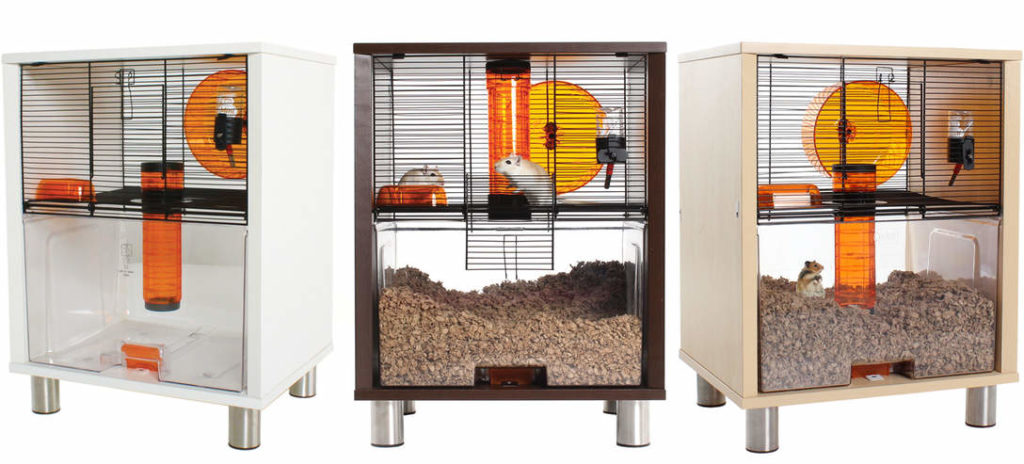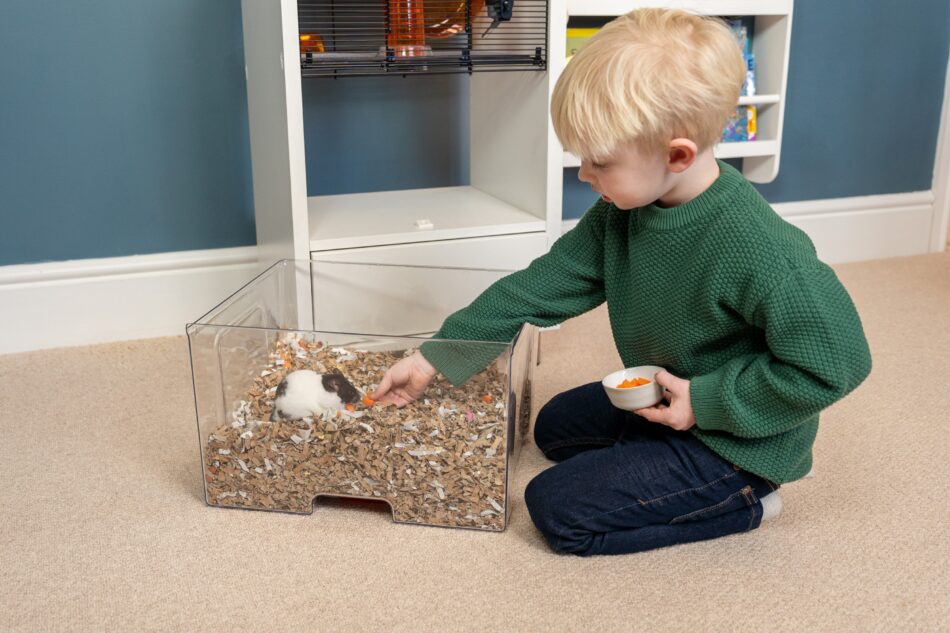 There are five hamster species commonly kept as pets. They are all similar in their needs, but with one or two important differences between species.
There are five hamster species commonly kept as pets. They are all similar in their needs, but with one or two important differences between species.
The most familiar is the Golden, or Syrian hamster, which is also the largest of the five. The others are all in the group known as Dwarf hamsters – Campbell’s, Roborovski, Chinese and Winter White.
Looking After a Golden Hamster
An estimated 75% of pet hamsters are Syrians, largely because they have been popular for many years, and are therefore widely available. This species 6–7 inches long, and is relatively slow moving (compared to the much nippier Dwarf species). This makes them easy to handle, and that is one of the keys to their popularity. A nervous owner will find handling very easy (i.e. the hamster is not going to run up your sleeve or make a bolt for the door before you can stop it!)
The Golden is a loner, and that means its owner will be its only companion – which is great for forming owner–pet bonds. The hamster will usually live for 2 to 2 ½ years, and can be hand-tamed from a very early age, so you will usually have a long and satisfying friendship with these little bundles of fun.
There are different types of Golden hamster. One of the most popular is the long-haired ‘Teddy Bear’. There are also different color varieties, with mixtures of gold, brown, russet, yellow, grey, black, and white.
IDEAL FOR: first time hamster owners looking for a single, easy-going pet that is easy to handle.
Looking After a Chinese Hamster
The Chinese – also known as the Striped, Grey or Rat-tailed – is the least common of the hamsters in the pet trade, although its popularity is growing all the time. There is a lot to love in these little characters – they are very gentle, and once hand-tamed they will love their daily human interaction.
This species grows to a length of between 4–5 inches and, and is dark grey with a darker stripe running down the back. It has a long tail, by hamster standards, hence the ‘Rat-tailed’ tag label. It tends to live a little longer than the Golden hamster, with a lifespan of 2 ½ to 3 years, and like the Golden it likes to live alone. This makes it bond very easily with a human companion.
IDEAL FOR: first time owners, or owners looking for something a little less common than the Golden, but with a similar personality.
Looking After a Roborovski Hamster
This is a lively little pet, and likes to live with at least one other fellow Roborovski – in a same-sex pair or small group. Single animals will do just fine, though, as long as they get lots of human company and handling. They are 10 cm (4 inches) long, and are endlessly curious about the world around them. When handling, you need to be alert, as these are fast movers.
Roborovskis are long-lived, by hamster standards, generally lasting between 3 and 3 ½ years. Being keen climbers and explorers, they will need a cage large enough to accommodate their endless expeditions, so space is sometimes an issue for would-be owners. They also have a rather strong smell, so they need cleaning out very regularly.
IDEAL FOR: owners who want to keep more than one hamster at a time, and have space for a larger cage.
Looking After a Winter White Hamster
This species is also called the Siberian, due to its wonderful color change during the Winter. It is grey-brown for much of the year, with a handsome black stripe down its back. In Winter the fur becomes white, but the black stripe remains.
This little creature reaches just over 4 inches in length, and can live alone very happily, making it a good pet for someone who has lots of time to handle and bond with their pet, and who is not nervous handling a fast-moving, small animal. Winter Whites only live 1 ½ to 2 years, and this makes them less popular than some of the other species.
IDEAL FOR: hamster lovers looking for a change from the commoner species, and who cannot wait to see that wonderful change to wintry white!
Looking After a Campbell’s Hamster
This is another short-lived hamster, with a lifespan of 1 ½ to 2 years. They are usually kept in same-sex pairs or groups, but can thrive alone as long as they get a lot of handling and attention from their owner. Their small size makes them tricky to handle, being both swift and fragile, so they are not suitable for young or nervous owners.
IDEAL FOR: owners who want to keep a group of hamsters together in a larger cage.

This entry was posted in Hamsters
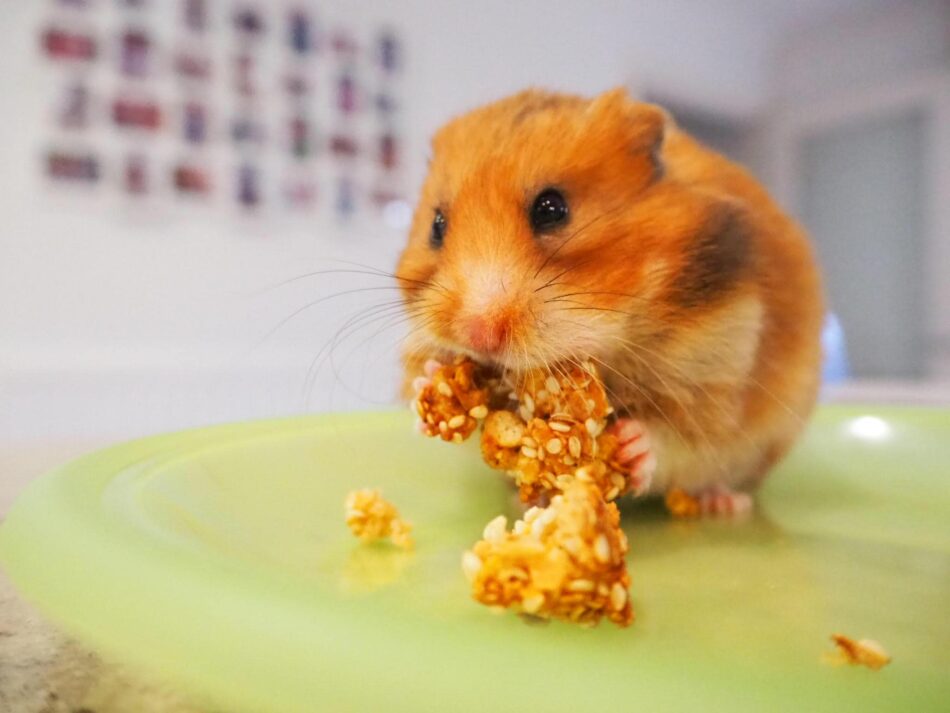
Hamsters are known for adorably stuffing food in their cheeks, giving them a puffy, caught-with-their-paws-in-the-cookie-jar look. But what exactly enables them to carry food in their mouths, and what do they do with it once it’s there? We’ll share 9 things you may not know about hamster cheek pouches so that you can understand your furry friend’s peculiar behavior a little bit better.
9 things you might not know about hamster cheek pouches
All hamsters have cheek pouches, but what are they for, and how do they work? Let’s dive into those deep cheek pouches — if there’s still room!
Cheek pouches are part of hamster anatomy
What we call a “cheek pouch” is actually expandable parts of your hamster’s oral mucosa, or the lining of the cheeks. When they’re empty, your hamster’s cheek pouch looks like a small, deflated balloon. Once your hamster starts filling their pouches, they can expand all the way back to their shoulders. In fact, a hamster can stuff up to 20% of their body weight into their cheek pouches. That would be like a 120 lb human carrying an extra 24 lbs worth of food around in their mouth.
They act like a built-in lunchbox
The main purpose of their cheek pouches is to carry food. In the wild, hamsters use their cheeks to carry food back to their home to enjoy it in a safe, quiet place. Domesticated hamsters exhibit the same behavior. You may observe your hamster depositing its proffered cheek pouch items in their hideout, play tunnels, or hamster sleeping area.
Food to-go
Hamsters can both run and eat with their cheeks full. In fact, hamsters can still eat when their cheek pouches are full. They’ll stuff their cheeks full, then eat some bites before taking their packed food back to their destination. And, even with all of the extra weight of full cheek pouches, hamsters aren’t slowed down by their to-go meals.
Dry storage
Here’s a fun fact: hamsters don’t release saliva into their cheek pouches. This keeps their packed lunches nice and dry and prevents bacteria from building up in their mouths. Hamster dentists are in short supply, so keeping their teeth free from moist food is important for overall oral hygiene.
Backup baby carrier
This isn’t something you’ll likely see in your domesticated hamster, but female hamsters can actually secure their babies in their cheek pouches to make a quick getaway, or to serve as an emergency hiding spot. Packing their babies in this way is only used as a last resort when their nest is being threatened.
Taking out the trash
Hamsters are actually pretty tidy creatures that don’t appreciate spoiled food in their pantries. They’ll use their pouches to stuff and carry spoiled food away from their fresh goods. This too is not very common with domesticated hamsters that have a clean cage, so having an easy-to-clean hamster cage will aid your furry friend in their housekeeping endeavors.
A wheelbarrow or shopping cart
How would you like to carry your latest decor or bedding finds home in your mouth? That’s exactly how hamsters sometimes use their cheek pouches — as vessels to carry bedding and nesting or building materials to the home.
Playing favorites
Some hamsters favor one side of their mouth over the other, while some will happily stuff both cheeks full. Watch to see if your hamster is a left or right-stuffer, or an ambi-stuffer.
A potential problem site
It’s possible for cheek pouches to be punctured or have abscesses form in them. You should keep an eye on your hamster’s overall health, with special attention on their mouths. If you notice any lumps that linger for more than a day, contact your veterinarian.
Omlet and your hamsters
Hamsters are amazing animals that are a pleasure to share a home with. Their quirky but lovable personalities are what inspired the Qute hamster cage. We wanted hamsters to have their ideal home, but one that was easy for their owners to keep clean while looking great in any room of the house. With a Qute hamster cage by Omlet, you’ll be able to see your hamster stuff their cheeks along with all of their other adorable behaviors up close and personally.
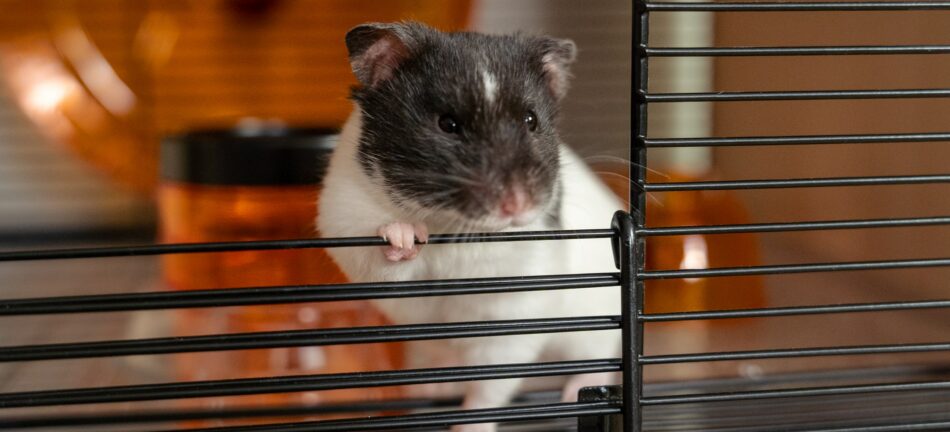
This entry was posted in Hamsters
All hamster owners know that they make great pets! They are cute and cuddly, but also very independent and clever. Whether you’re a beginner or a long term hamster fan there is always more to learn about these amazing critters! That’s why we’ve put together this Best of Hamsters, a few blog blogs with more information and advice, perfect for teaching your children about their pet, as well as some DIY fun you can do together!
Interesting Facts About Hamsters

Hamsters are rodents from the subfamily Cricetinae. They were brought to the United States from Syria in 1936. There are approximately… Read more
How to Understand Your Hamster’s Body Language

Hamsters make excellent pets – they’re fun, cute, and relatively easy to care for. Their cuddly credentials have made them popular pets all over the world. Hamsters bring a lot of joy to a lot of people, but how can… Read more
Want to Teach your Hamster Tricks? Here are our Best Tips!

Someone once said that you can train anything that has a brain that connects to a stomach, and that goes for hamsters as well. They are actually very clever little creatures and probably capable of more than you think – like learning tricks for example! Training your hamster is a… Read more
Get Creative – Make a Hamster Maze

Hamsters love to play and explore! There are many toys and treats available to buy for your furry friend, but wouldn’t it be great to design and construct an exciting maze for them? They are… Read more

Download this cute colouring page and print for the whole family to enjoy! Send us your finished images, we would love to see them!
This entry was posted in Hamsters

Hamsters love to play and explore! There are many toys and treats available to buy for your furry friend, but wouldn’t it be great to design and construct an exciting maze for them? They are easy and fun to make and will provide hours of fun!
Here’s what you’ll need:
- A shallow box, something like a vegetable box from a supermarket or an old suitcase.
- Thin cardboard to make the walls, tunnels and other parts of the maze.
- Non toxic glue – we used a glue gun.
Now for the fun part!
Create walls, tunnels, bridges, caves and more, securing them to your box using non toxic glue. The more things in the maze, the better!
We added a little teepee as a finish point, and placed a treat inside for our hamster to find.
Not all routes need to lead to the teepee. Some paths could lead to a dead end, or you could give your hamster an option of two different tunnels to go through, leading to two different parts of the maze. The green tunnel or the yellow tunnel…which will your hamster choose?
Your hamsters will more than likely try to climb out of their maze from time to time so make sure you keep a close eye on them while they are having fun exploring!
Grab some card, glue and a box and get creative!
We’d love to see photos of the mazes that you produce, please send them to marketing@omlet.us and we will share our favorites!
This entry was posted in Hamsters

Have you ever found yourself wondering how to find a lost hamster? Hamsters will seize any opportunity to go on a house-wide adventure. Thankfully, there are a few things you can do to make your quest for your missing hamster easier. Stay calm – they may be tiny, but hamsters aren’t as hard to find as you might think. By following our tips, you’ll be reunited with your furry friend in no time.
Why did my hamster escape?
It’s helpful to understand why a hamster would want to leave their cage in order to make a plan to find them and to prevent future escape attempts. Hamsters will usually try to escape from their cage for the following reasons:
- They aren’t comfortable in their home
- Their cage is in a noisy or stressful environment
- If they feel they don’t have enough space
If you think one of the above reasons may have contributed to your hamster wanting to seek shelter elsewhere, it may be time to upgrade your hamster’s cage. A cage with more room will make your hamster more comfortable. Choose a cage with wheels to easily relocate your hamster to a more quiet spot in the house without jostling them.
Hamsters may also take advantage of an unsecured or loose cage door, so reinforcing it with clips or other safety features may be helpful to prevent future breakouts.
6 Tips to find a lost hamster
Many hamsters can be found once they’ve left their cages. The most important things to remember are to be patient and calm – your hamster likely hasn’t gone far.
1. Don’t look during the day
Hamsters are nocturnal by nature (meaning they sleep during the day and are most active at night). During daylight hours, your hamster will be curled up in a cozy sleeping spot and will want to remain there all day. Unless you stumble across them while cleaning under furniture, you’re not likely to find your hamster during daytime hours.
2. Bring out the treats
Leave your hamster’s favorite treats in corners of the room (or rooms) where you think they may be and check to see if any get eaten. Bananas are a great treat to try and tempt them with. You can also place treats inside of a small shoebox or other cozy quarters with some snooze-worthy bedding during the day. This will help encourage your hamster to venture into your makeshift home to take a nap. Check your treats periodically throughout the day for nibbles or maybe even catch a glimpse of your elusive pet.
3. Turn the lights off
You may be able to encourage your hamster to move around if the room is dark. At nightfall, turn out the lights and sit quietly with a flashlight ready to turn on if you hear your hamster in the room.
4. Become a secret agent and look for paw prints
Sprinkle flour or cornstarch across doorways or in front of any assumed hamster hiding spots. Your little friend will pass through the powder and leave footprints on the other side – giving you a clue as to which direction they went.
5. Stop and listen
Hamsters make some tell-tale sounds like squeaking or snuffling. Listen carefully in a quiet room to see if you hear any of your pet’s sounds. If you left crunchy treats out as bait, listen for the little grinding of teeth or food pieces dropping and hitting the floor.
6. Get high-tech
If you have security cameras or baby monitors, set them at floor level to see if you can catch your escapee on film. If you’re able to narrow down your hamster’s location to one or two rooms, set up multiple cameras to catch different angles.
Finding their own way home
Sometimes hamsters will come back to their cage on their own, so try leaving their cage on the floor with the door open, with a fresh supply of food, and your wanderer may return. Eventually, they’ll get hungry and appear when you least expect it – so it helps to be prepared.
Escape-proof your cage
The best way to avoid having to track down a lost hamster is to prevent escapes from happening in the first place. But there’s more to escape-proofing your hamster’s cage than just reinforcing the doors. Hamsters need to feel safe and secure in their home, with plenty of room to burrow and explore. The Qute Hamster Cage by Omlet offers lots of space both for sleep and play, and has owner-friendly features that make taking care of your hamster fun and easy.
Placement of your hamster’s home is important. Set up their cage in a location that’s free from drafts and noisy daytime activity, but that’s also in a common area so that they feel like part of the family. The Qute hamster cage is designed to look like a modern piece of furniture that blends in with virtually any home decor style.
Bring them out for supervised play
Let your hamster enjoy time out of their cage by providing them with a playpen full of hamster toys. Make sure the playpen you construct or purchase is suitable for the size hamster you have. Smaller breeds of hamsters require smaller bar spacing than larger breeds. Get creative and make a maze for your hamster from cardboard boxes or paper tubes, or construct an obstacle course from wooden blocks or other hamster-appropriate household scraps.
Omlet and your hamster
Like all of our pet products, Omlet designed the Qute Hamster Cage to bring you closer to your pet. The Qute cage is easy to clean, goes with any home’s aesthetic, and will make your hamster feel safe and secure – never needing to feel the need to seek out other housing arrangements. It’s easy to avoid hamster escapes and enjoy interacting with your furry friend when you have a Qute cage.

This entry was posted in Hamsters
Hamsters make excellent pets – they’re fun, cute, and relatively easy to care for. Their cuddly credentials have made them popular pets all over the world. Hamsters bring a lot of joy to their owners, but how can you tell if your hamster is happy? Knowing how to understand your hamster’s body language will help you determine what your pet is feeling at any given time. Discover the wide range of emotions that hamsters can convey to their owners, and how to decipher their body language. Before you know it, you’ll be an expert in hamster habits.
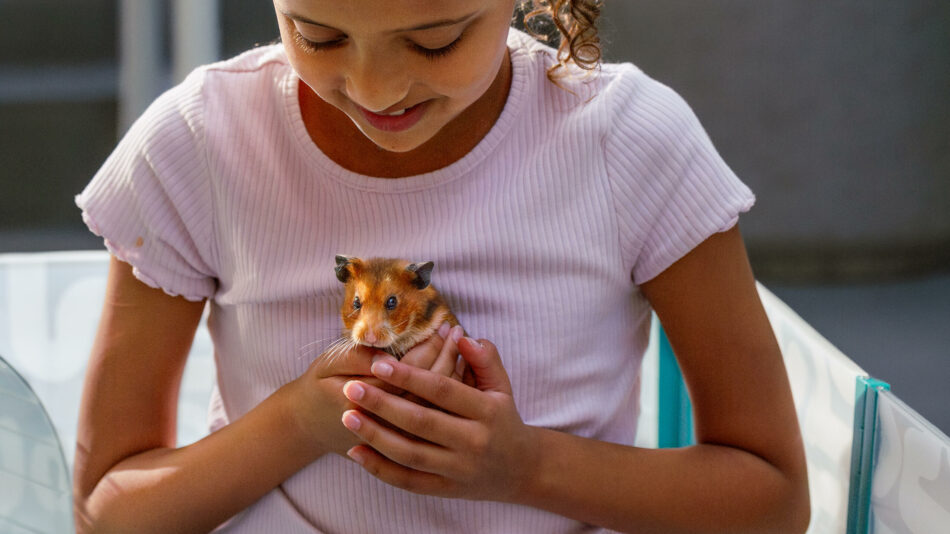
Positive body language
A happy hamster is the result of good care, adequate nutrition, and ideal living conditions. If you notice these behaviors in your hamster, give yourself a round of applause for your excellent hamster husbandry skills.
Stretching and yawning
Yawning doesn’t just convey the desire to sleep — in fact, your hamster will yawn or even stretch when they’re feeling comfortable and relaxed. If you see your hamster stretching out in a wide-mouthed yawn, they are saying they’re perfectly happy and content in their environment.
Sitting up on back legs, ears forward
This perked-up posture is exactly what it looks like: something has captured your hamster’s attention. Hamsters will sit up on their haunches to get a better vantage point, and will point their ears forward to enhance their hearing.
Leaping
Hamsters might not be readily associated with acrobatics, but they can quite literally jump for joy, or leap during their active hours while scurrying around their habitat. These hops, bounces, or bounds stem from their playful natures, but also from natural instincts to hop over rough terrain. So, if you see your hamster bouncing around their enclosure, they’re either expelling playful energy, or exercising their natural instincts.
Grooming
Being the clean animals that they are, hamsters spend a lot of time grooming themselves. But in order to clean their fur, faces, and paws efficiently and thoroughly, hamsters need to feel secure in their surroundings. When you see your hamster grooming themselves, you know they feel confident and comfortable.
Ears folded back, eyes half closed
This is the look of a hamster who has just woken up. It could be during the day if they wake up for a midday snack or sip of water, or as they’re emerging from their daily slumber to begin their nocturnal active hours. It’s best not to disturb your hamster while they are sporting this squinted look — it’s the equivalent of talking to someone before they’ve had their morning coffee.
Neutral body language
Not all body language has a good or bad connotation. Some of your hamster’s body language is brief, or is the result of a reflexive response. These behaviors are all normal, and don’t indicate that your hamster is overly stressed or stimulated.
Ears laid back
This behavior communicates that your hamster is suspicious of something. It could be an unusual sight or smell, or as a reaction to a sudden change in their environment. Your hamster’s ears should return to their usual, relaxed state after a moment or two. It’s important to not approach your hamster while they have this posture to avoid startling or stressing them.
Freezing
You may see your hamster staying in one position — sometimes for even a few minutes. Their ears will be straight up and they will be stiff to the touch. There are lots of potential reasons for hamsters to stop moving temporarily: they can freeze both out of fear and surprise, or they can pause their movement so that they can listen more carefully to something that they’re unsure about.
Running
Running is a normal, important part of your hamster’s routine. In fact, in their natural habitat they can run up to 5 miles each night. It’s important to provide your hamster with an exercise wheel to fulfill their need to move. Not only will it keep them from becoming overweight, but it will also stimulate their mind.
Negative body language
Sometimes your hamster may need to convey negative emotions or experiences. Feelings like pain, stress, or illness can be expressed through body language. You may never see these in your pet, but it’s still important to recognize negative hamster behavior so that you can address it promptly.
Repetitive actions
If you notice your hamster wearing a path in their bedding from pacing, or engaging in a loop around their cage that consists of repetitive actions, they may be stressed. A hamster stuck in a loop of activity, like hopping on their exercise wheel, followed by a lap around their habitat and repeating over and over is experiencing mental stress. Hamsters displaying this behavior should be checked over for any injury, and may benefit from having their habitat rearranged, or from the addition of some enriching toys or accessories like hamster tubes, ramps, or platforms.
Chewing
Chewing on the bars or edges of their cage, toys, or food bowls can indicate that your hamster is stressed. It could also mean that your hamster’s teeth are overgrown, or that they’re bored. Make sure that your hamster has plenty of space in their habitat, and that they have access to Timothy hay or applewood chews to correct inappropriate chewing.
Biting
Hamsters can bite when they’re scared, stressed, or confused. If your hamster nips you, there’s definitely a reason behind it. Your hamster may be in pain, or in a state of mind where they aren’t sure how to react to you — usually when woken up from a deep sleep. It’s important to try to understand why your hamster has reacted by biting rather than being angry at them for doing so.
What to do about negative body language
If you see your hamster exhibiting signs of stress or discomfort, it’s time to perform a hamster health check. Depending on your findings, you may be able to resolve the issue and help them feel more comfortable right away. If you find anything troubling, like signs of illness or injury, contact your veterinarian for advice, or to schedule an exam.
Omlet and your hamster
Knowing that your hamster is healthy and happy is one of the most rewarding feelings as an owner. Our hamster habitat and accessories have been designed to foster your pet’s needs and behaviors so that they can live full, happy lives. We’ve also crafted all of our hamster products to bring you and your small pet closer than ever with the accessible and easy to clean designs. Enjoy a lifetime of understanding and enjoyment together when you choose Omlet for your hamster’s housing needs.


This entry was posted in Hamsters

Someone once said that you can train anything that has a brain that connects to a stomach, and that goes for hamsters as well. They are actually very clever little creatures and probably capable of more than you think – like learning tricks for example!
Why Should I Train My Hamster?
Training your hamster is a wonderful way to vary your daily playtime and spend time together, and it’s something that both stimulates your pet mentally and creates a strong bond between the two of you. It should be said though that this training takes a lot of time and patience, and every hamster is different, so there’s never a guarantee that your hamster will learn these specific tricks, or any tricks at all.
Can I Train a Hamster of Any Age?
As with most pets there are advantages of getting a young hamster when it comes to training and getting the hamster used to you and your family, as they have not yet developed habits and routines that can be difficult to break. This is not to say you can’t teach an old hamster new tricks, but it will take much longer to train him or her.
Where to Begin
The most important thing is that your hamster feels comfortable around you, and that your smell and your voice has a positive association. Try to always stay calm around your hamster, and avoid raising your voice, as that can cause unnecessary stress. Spend a good few weeks together with your hamster before you move on to tricks, so you know that you can trust each other!
Now you need treats. Maybe you already know what your hamster’s favorite is, but if you don’t, we recommend sunflower seeds. They are however very fatty, so make sure that you limit the intake to training sessions or special occasions. You can also try with small pieces of chopped vegetables like carrots or broccoli.
What Tricks Can I Teach My Hamster?
- STAND
Start with an easy trick, a good first one is ”stand”. Hold the treat in front of the hamster just over its head so that the hamster can see it but not reach it. As you do this, use your command ”stand”. Your hamster will instinctively stand up to get closer to the treat. When the hamster stands, give the treat and verbal praise. Only give the treat if the hamster stands, as they otherwise won’t understand why they are being rewarded. If your hamster doesn’t stand it might be because he or she is not hungry at that moment, or distracted by something else going on in the room. Try again a bit later. Repeat this a few times a day for a week or two, until your hamster stands even when you don’t have a treat in your hand. Stick to one command at the time, and still always reward the hamster for standing. - JUMP
Now you can move on to another trick. Use the ”stand” command, and then move the treat up and forward and say ”jump”. If the hamster tries to jump, praise him or her and give the treat. If your hamster is happy to jump you can add a hoop into the mix. Hold some sort of hoop between the hamster and a treat, so that they have to move through the hoop to get to it. As they go though, say ”hoop” or ”jump through the hoop”. Start with the hoop touching the ground, and then gradually lift it if your hamster seems to enjoy the game. - ROLL OVER
Another fun and easy trick is ”roll over”. All you need to do is to carefully place the seed on your hamster’s back and ask him or her to roll over. If they do it, reward them with the seed. After a while the hamster will roll over even without you putting the seed on their back.

Be consistent with the training, and let it take time, but it doesn’t hurt to shake up the routine every now and then to keep things interesting. Some tricks are easier than others, and all hamsters are different, so be patient and do not push your pet or get frustrated if it’s taking longer than you expected.
If both you and your hamster enjoy the training, there is really no limit as to how much you can teach your pet. You can use toys or build obstacle courses; make up the tricks as you go along and show off to friends and family!
This entry was posted in Hamsters
The school summer holidays are in full swing and there’s no better time to do some baking with the kids! Ruby and Harry decided they would like to make some treats for their Syrian Hamster called Ginny!!
So here’s a simple recipe to make some yummy Crunchy Honey Delights!
Ingredients:
Cheerios (sugar-free kind)
Sesame Seeds
Honey
Oats




1. Add sesame seeds and oats into a bowl



2. Crush the Cheerios in a small bag, don’t crush them into dust, just small pieces


3. Add the Cheerios to the sesame seeds and oats and mix together


4. Drizzle honey over the mixture and coat well


5. Use your fingers to mold the mixture into small balls that your hamster can hold,
then put them on a baking tray and into the fridge for 15 minutes


6. Heat your oven to 370 degrees farenheit and bake treats for 8-10 minutes and then let them cool completely


7. It’s time for the taste test….. does Ginny like the new treats….?



8. Ginny loved the Crunchy Honey Delights!
Happy Baking and remember to only give your Hamster little treats once or twice a week!
Check out the Qute Hamster House from $99.00.
This entry was posted in Hamsters
 There are five hamster species commonly kept as pets. They are all similar in their needs, but with one or two important differences between species.
There are five hamster species commonly kept as pets. They are all similar in their needs, but with one or two important differences between species.





































